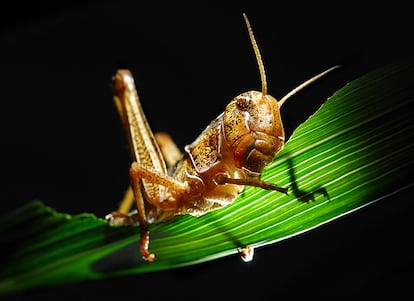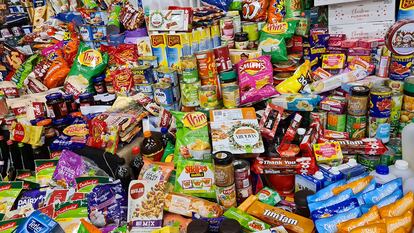Stephen Simpson, nutrition expert: ‘Ultraprocessed foods have been designed to hack our biology’
The researcher explains that our bodies crave more food if we haven’t had enough protein, and this can lead to a vicious cycle — especially if we’re reaching for ultraprocessed instead of high-fiber whole foods

This story starts in an unusual place for an article about human nutrition: a cramped, humid and hot room somewhere in the Zoology building of the University of Oxford in England, filled with a couple hundred migratory locusts, each in its own plastic box.
It was there, in the late 1980s, that entomologists Stephen Simpson and David Raubenheimer began working together on a curious job: rearing these notoriously voracious insects, to try and find out whether they were picky eaters.
Every day, Simpson and Raubenheimer would weigh each locust and feed it precise amounts of powdered foods containing varying proportions of proteins and carbohydrates. To their surprise, the young scientists found that whatever food the insects were fed, they ended up eating almost exactly the same amount of protein.
In fact, locusts feeding on food that was low in protein ate so much extra in order to reach their protein target that they ended up overweight — not chubby on the outside, since their exoskeleton doesn’t allow for bulges, but chock-full of fat on the inside.
Inevitably, this made Simpson and Raubenheimer wonder whether something similar might be causing the documented rise in obesity among humans. Many studies had reported that even as our consumption of fats and carbohydrates increased, our consumption of protein did not.
Might it be that, like locusts, we are tricked into overeating, in our case by the irresistible, low-protein, ultraprocessed foods on the shelves of the stores where we do most of our foraging? That’s what Raubenheimer and Simpson, both now at the University of Sydney, argue in their recent book Eat Like the Animals and in an overview in the Annual Review of Nutrition.
Simpson took us through the reasoning and the data in an interview with Knowable Magazine. This conversation has been edited for length and clarity.
Q. How does an entomologist end up studying nutrition in humans?
A. My interest in feeding behavior goes all the way back to my undergraduate years in Australia, where I was studying the food choices of sheep blowfly maggots, which are laid in the wool of sheep and eat the sheep alive. For my PhD, I took an opportunity at the University of London, England, to study appetite and food intake control in migratory locusts, which exist in two extreme forms — one solitary and one aggregating in swarms that create devastating plagues.
Since they had this reputation for being absolutely voracious, we surely did not expect them to have a lot of nuance in the way they control what they eat. But I started to explore whether they could sense the requirement for different nutrients and use it to regulate their intake. That led to experiments with artificial diets of different nutrient compositions, which showed that locusts have nutrient-specific appetites for protein and carbohydrate: Their food tastes differently to them depending on what they need, and that enables them to balance their diets.
In 1987, I started working with David Raubenheimer at Oxford to find out what happens if you put locusts on a diet that forces different appetites to compete, by feeding the animals mixtures of proteins and carbohydrates in relative amounts that do not match their intake target. We made 25 different diets, measured how much the locusts ate, how quickly they developed, and how big they grew, and found that when protein and carbohydrate appetites compete, protein wins.
What that means is that if you put animals on a low-protein, high-carb diet, they’ll eat more calories to get that limiting protein, and they’ll end up obese. Likewise, if you put them on a high-protein, low-carb diet, they don’t need to eat as much to get to their protein target, and they end up losing weight. It was at that point that we knew we had discovered a powerful new way of looking at nutrition.
We started looking at lots of different species of insects, and found that they, too, had the capacity to regulate their intake of protein and carbohydrate, and that protein was often, but not always, the prioritized nutrient.
By now, we have studied species from cats, dogs and free-ranging primates to fish in aquaculture to slime molds to humans, in a variety of contexts — from understanding health and disease to optimizing animal feed to conservation biology.

Q. You’ve found that the nutrient levels that animals aim for are the ones at which they grow, survive or reproduce best. Just by following their appetite, they eat exactly what they need. Why don’t we?
A. There are two possibilities. Either our biology is broken, or it still works but we’re in the wrong environment. What we’ve shown in our studies is the latter. What has happened is our appetites, which evolved in natural environments, have now been subjected to highly engineered food environments which have been designed, in many ways, to hack our biology, to subvert our appetites.
One of our favorite examples came from a study we did in Sydney. We confined people in a sleep center for three four-day periods and provided them with foods and menus which were varied and matched in palatability, but were all of the same nutrient composition for a given week.
We had a 25% protein week, a 15% protein week, and a 10% protein week, and the subjects didn’t know that was going on. As far as they were concerned, they were allowed to eat what they wanted, everything tasted equally well and there were lots of choices. But it turned out that during the low-protein week, people ate more, because their protein appetite would drive them to eat more calories, to try and get enough protein. They largely did this by increasing snacking between meals, and selectively on savory-flavored snacks.
We’ve subsequently discovered that when you’re low in protein, as is the case on a 10% protein diet, you have elevated levels of a hormone called FGF21, which is mainly released from the liver. What we’ve shown in mouse experiments and confirmed in humans is that FGF21 switches on savory-seeking behavior, which is a proxy for eating protein.
Now, if you have that response and the nearest savory thing is a bag of barbecue-flavored potato crisps, that’s a protein decoy. You’ll be misdirected to eat that, but you’ll not get any substantial amount of protein. You’ll remain protein-hungry, and you’ll have to eat more to satisfy that protein appetite. That means you’re accumulating excess calories, and that is precisely what happens to us in our modern food environment.
Q. You argue that ultraprocessed foods are especially likely to make us consume too many calories. Why would that be so?
A. Over the last couple of years, population survey data have shown that the average person in the U.S., Australia or the U.K. gets more than half their calories from highly processed foods — in some cases it’s 90% or more. As the proportion of ultraprocessed food in the diet increases, protein intake remains largely the same, but energy intake goes up steeply because of the dilution of protein by the fats and carbs in these foods. So this protein appetite we discovered initially in locusts operates in us too. In our modern food environment, it drives us to overconsume energy, and that sets up a vicious cycle.
What we find is that as people become overweight, their metabolism becomes dysregulated. Their tissues become less responsive to insulin, which normally regulates protein metabolism. This makes protein metabolism less efficient, causing the body to break down lean tissues like muscle and bone and burn protein to produce energy.
That increases people’s protein target, so they’ll eat even more, put on more weight, become even more metabolically dysregulated, start craving more protein, and so on.

We’ve since taken that basic idea and used it in a paper at the end of last year to propose a new understanding of why women are prone to put on weight during menopause. That’s a period when protein breakdown rates go steeply upwards in bone and muscle because of the decline in reproductive hormones. And it is driving the same sort of outcome that I just described.
You also see it in aging, you see it in people who smoke, you see it with excess alcohol intake — these are all circumstances in which FGF21 goes up, protein appetite goes up, protein breakdown goes up, and you’ll end up in this sort of vicious cycle.
Q. As an entomologist, how did you manage to convince colleagues in nutrition science this matters?
A. It’s just the accumulation of evidence. Last fall, we spoke at the Royal Society in London at a big obesity conference, and the response to our talk indicated to me that protein leverage is now accepted as one of the main, credible underlying explanations for obesity. Our evidence comes from pre-clinical studies, it comes from clinical studies, it comes from cohort studies, it comes from population-level analyses, it comes from deep mechanistic biology — it’s now unanswerably there. The remaining question is: Of the various influences that drive obesity, is protein appetite a main one? We think it probably is.
Q. Why would protein be the strongest driver of our appetites? What would be the biological logic?
A. All three macronutrients — fat, carbs and protein — contain calories, so we can burn any of them to yield energy, and we can use any of them to make glucose, which is the preferred fuel for our cells and brain.
But only protein has nitrogen, which we need for many other purposes, from maintaining our cells to producing offspring. You don’t want to eat too little protein.
That leaves the question of why we don’t overeat it. Why do we eat fewer calories than we need on a high-protein diet, rather than eat excess protein? To us, that implied there is a cost to eating too much protein, and we set out to discover that cost in fruit flies. We designed a large experiment where we confined a thousand flies to one of 28 diets varying in the ratio of protein and carbohydrate, the two major macronutrients for flies. What we found was that flies lived longest on a lower-protein, high-carbohydrate diet, but laid most eggs on a higher-protein, lower-carbohydrate diet. A really-high-protein diet, finally, wasn’t better for either outcome.
That overturned a hundred years of thinking around restricting calories and aging: The dominant view was that reduced calories were what prolonged life, but our data showed that the type of calories matter, notably the ratio of protein to carbs. And it created quite a stir at the time — the paper came out in 2008.
We set out to do the same experiment in mice. To do that, we had to add fat as a third nutrient dimension to the dietary design. That involved an enormous study. We took more than 700 mice and put them on one of 25 different diets varying in the concentration and ratio of protein, carbohydrate and fat. It took 6 metric tons of experimental diet to run that study across the 3 or 4 years it took before the oldest mice died.
That was the first of a whole series of huge mouse experiments where we looked at different types of carbohydrate, different ratios of amino acids, and so on. The long and the short of it was that the mice lived longer on low-protein, high-carbohydrate diets, but reproduced better on high-protein, low-carbohydrate diets — very similar to the flies.
Importantly, the benefit of low protein was only realized when the carbohydrates were harder-to-digest complex carbohydrates like fiber and starch, not simple sugars. If you translate that into human populations and look across the world for human populations that live the longest, lo and behold they’re the ones on diets low in protein and high in healthy carbohydrates and fats, such as Mediterranean-style diets and the traditional Okinawan diet.
Q. I’m sure they’re all very healthy, but how do people on these diets manage their appetites?
A. That’s a really interesting question. The Okinawans certainly are hungry for protein. In traditional Japanese cuisine, there is an almost religious prominence given to umami flavors, which are the signature of protein, the savory characteristic in foods. So that’s like a societal protein appetite.
The other question is: On a 10% protein diet like the Okinawan diet, why aren’t they all suffering obesity because they have to eat far more to get their protein? The answer is that the traditional diet is low in energy, and high in fiber. By eating more to try and attain their protein target, they get more fiber instead of more calories, until their stomach is full. That’s a crucial distinction with the modern industrialized food environment, which isn’t just low in protein, but also low in fiber — and high in fats and carbs.
Tim Vernimmen, a freelance science journalist based near Antwerp, Belgium, has always had a healthy appetite, but now wonders how fitting that term really is. He does like to cook, which helps him steer clear of highly processed foods most of the time.
This article originally appeared in Knowable Magazine, an independent journalistic endeavor from Annual Reviews.

Tu suscripción se está usando en otro dispositivo
¿Quieres añadir otro usuario a tu suscripción?
Si continúas leyendo en este dispositivo, no se podrá leer en el otro.
FlechaTu suscripción se está usando en otro dispositivo y solo puedes acceder a EL PAÍS desde un dispositivo a la vez.
Si quieres compartir tu cuenta, cambia tu suscripción a la modalidad Premium, así podrás añadir otro usuario. Cada uno accederá con su propia cuenta de email, lo que os permitirá personalizar vuestra experiencia en EL PAÍS.
¿Tienes una suscripción de empresa? Accede aquí para contratar más cuentas.
En el caso de no saber quién está usando tu cuenta, te recomendamos cambiar tu contraseña aquí.
Si decides continuar compartiendo tu cuenta, este mensaje se mostrará en tu dispositivo y en el de la otra persona que está usando tu cuenta de forma indefinida, afectando a tu experiencia de lectura. Puedes consultar aquí los términos y condiciones de la suscripción digital.
More information
Últimas noticias
Most viewed
- Reinhard Genzel, Nobel laureate in physics: ‘One-minute videos will never give you the truth’
- Oona Chaplin: ‘I told James Cameron that I was living in a treehouse and starting a permaculture project with a friend’
- Pablo Escobar’s hippos: A serious environmental problem, 40 years on
- Why we lost the habit of sleeping in two segments and how that changed our sense of time
- Charles Dubouloz, mountaineering star, retires at 36 with a farewell tour inspired by Walter Bonatti










































